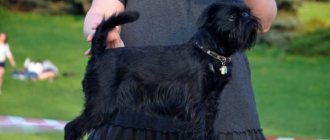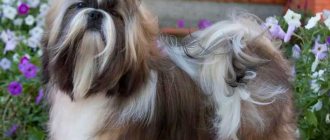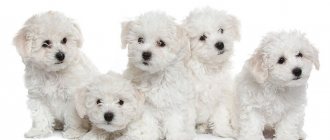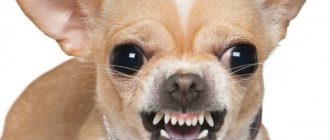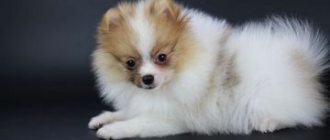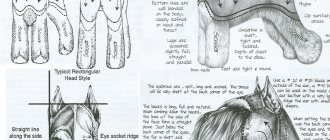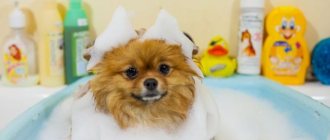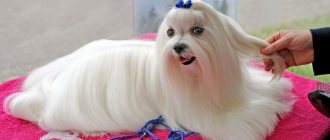If a dog has short hair, this does not mean that it does not need care, or that it will include some primitive methods. The coat of the Brussels Griffon is very specific, and therefore requires special care. Because of these features, the wool does not get wet and does not fall out. Many will consider this a plus, but not everything is so rosy and simple. Due to the fact that the hair does not fall out on its own, the griffon needs trimming every six months. We'll tell you what it is and what else the owner of the griffon will have to do.
Features of the griffin breed and coat structure
The average height of a griffin at the withers is about 20 cm, and its weight ranges from 3 to 5 kg. When looking at the dog, it is clearly noticeable that the head is disproportionately large in relation to the size of the body. The color of griffins can be any, the most common are black and red individuals.
There are 3 varieties of the griffin breed. They differ in the length and color of their coat:
- The Belgian has hard, medium-length fur, exclusively black;
- the Brussels has the same coat as the Belgian griffin, but is red in color, with undercoat and feathering on the paws;
- Petit Brabançon has short hair - black, red or tan.
All types of the breed, except the Brabançon, have a muzzle decorated with long hair. It forms a beard, mustache, sideburns, eyebrows.
Surprise for breeders
The breed is unique in that it has two subspecies: the Brussels Griffon and the Brabançon, and both can appear in the same litter, so breeders are always in for a surprise: who is it this time?
Brussels Griffons, unlike their Brabançon brothers, are shaggy and bearded, they have a hard coat with a thick undercoat. Brabançons are smooth-haired pets with a very gentle, shiny coat. They also shed. But this is perhaps their main difference from the “Brussels”, not counting, of course, the lack of a beard and shaggy hair.
Trimming
Griffons are not cut, but trimmed - dead hairs are plucked out. The first procedure is carried out at 3 months. Subsequent ones as needed. If hairs remain in your hands when stroking the dog, they need to be removed.
A special knife is used for trimming. Remove excess fur from the paws, tail, belly, chest, and near the anus. The recommended frequency is every 1.5 - 2 months, but at least once every six months.
Reproduction and lifespan
| Griffins are long-lived. Their lifespan is 12-15 years. |
To get a quality litter, you need to choose good parents. The owner of a bitch is looking for a male dog with a good pedigree, healthy, and excellent conformation. They agree on a price - usually a puppy from the litter - and wait for the dog to come into heat. Bitches of this breed may be in dry heat - the discharge is invisible, the female licks it off. The start of the hunt is indicated by a swollen noose.
There are three periods of estrus:
- Proestrus - the beginning of estrus, the processes preceding fertilization begin in the uterus, the loop begins to secrete pheromones that attract the attention of males, the discharge is light;
- Estrus is the middle, the female is ready for fertilization, the loop swells, the animal becomes disobedient, irritable, tries to run away in search of a gentleman;
- Metaestrus is the third stage, the effect of hormones subsides, the noose tightens, the girl becomes calmer. The discharge decreases, becomes lighter, and becomes mucous. If they don't stop, take the bitch to the vet.
The first three heats are missed, mating and childbirth are dangerous for young bitches; they can undermine health, causing irreparable loss for future matings. The fourth heat is the best option for mating.
The lady is taken to the gentleman's home. In a specially designated small room they get used to each other. Females are aggressive during hunting and can bite their partners, so owners must be present. You may need help for mating. Typically, hand-knitting is used for successful fertilization.
You need to know that obese, overfed girls cannot get pregnant, and boys are not capable of mating. Knowing the crumbs' predilection for food, they are somewhat limited before mating. After the first meeting, I let the lovers rest for a couple of days and repeat to consolidate the result.
Additional care for your griffon
In addition to the fur coat, the following are regularly inspected and cleaned:
- eyes – wipe off nitrous oxide every day with sanitary napkins;
- ears - wipe weekly with napkins or instill lotion and remove dirt with a sponge;
- claws - trimmed every month and a half with special scissors;
- teeth - cleaned weekly with brushes and toothpastes for dogs; if tartar has formed, it is removed by a veterinarian.
Their stubborn nature makes it difficult to care for griffins. They do not tolerate any “bullying” or attacks on personal freedom. Therefore, they often spin around and try to escape during grooming.
In order for the dog to sit quietly, it is taught hygiene from an early age. It is important to train her until she is 4 – 6 months old. To do this, first they “play veterinarian” - they examine the ears, teeth, and eyes several times every day. Then the dog is introduced to combs and scissors. For the first procedures, a couple of minutes is enough. Then their duration is gradually increased.
Same breed, different care
All Griffons require professional grooming. The choice of procedures will depend on the pet’s coat type, age and even habits. Brabançons need to be brushed regularly with a special brush. If your dog sheds, you need to do this several times a week to speed up the process of coat renewal.
Wirehaired Brussels Griffons require stripping approximately three times a year. But only a professional groomer can accurately answer the question of how often to strip your pet, and only after getting to know the dog.
Stripping is a rather labor-intensive process and is performed manually. The master plucks out excess hair with his fingers. Often before stripping, a special powder is applied to make the hair come off better. After stripping, the groomer can correct some individual areas (for example, the area above the nose, the stomach) using scissors. Brussels Griffons also need to comb their beard so that it does not become matted or shed.
Griffons love to spend time with their owners and walk outside. They can do this for hours without getting tired, which is amazing for such a small dog. Of course, this will get the fur dirty, so you will have to bathe your pet often. This is an important condition for your four-legged pet to remain not just beautiful, but also healthy. Any dirt is a source of pathogenic microbes. For “Brussels” you need to select shampoos for hard coats, and for Brabançons – for smooth coats.
You can bathe your pet at home, but it is better to go to a pet salon, where they will always recommend a shampoo that will not cause allergies and a conditioner that will moisturize the fur. Well, after bathing in the grooming studio, your pet will undergo another pleasant procedure - drying the fur with a hairdryer.
Belgian Griffon Nail Care
Usually, when a dog regularly walks on asphalt, its claws wear off on their own, but this does not always happen, and therefore it is necessary to trim your dog’s claws. You can entrust this task to a veterinarian or a professional dog groomer, but if you want to do the procedure yourself, ask your veterinarian to show you how it's done. It is better to use a special nail trimming tool.
There are two types of dog nail clippers: scissors and guillotine. I prefer the guillotine, but it's a matter of taste. The most important thing in this procedure is not to hurt the dog. You will hurt her once and she will hate this procedure forever. To avoid causing pain or injuring your dog, only cut 2mm beyond the red area of the nail. When in doubt, it is better to cut less. A puppy's nails should be trimmed at 2-3 weeks of age to avoid scratching the mother's belly. Accustoming your dog to this procedure from an early age is the best method to avoid unpleasant moments in the future.
Nutrition
Despite their tiny size, pugs love to eat well. They are playful, active, and expend a lot of energy. Therefore, dogs' diet should be varied and balanced. Some breeders prefer ready-made dry food. In this case, vitamins and mineralized supplements should be added.
Home pupils are fed:
- Cottage cheese, fermented milk products;
- Oatmeal or buckwheat porridge;
- Meat products, preferably chicken by-products - gizzards, hearts, livers.
- With a bone you can give a wing or a neck;
- Sometimes give a quail egg;
- A few vegetables, the pug is a real predator - initially did not eat vegetables;
- Add vitamins and minerals.
You should consult your veterinarian about vitamin supplements when determining the portions for a single dose of the drug. If the nutrition is correct. The pet will be cheerful, active, and have shiny fur. After eating, wash the puppy's beard, combing it to give it shape.
Griffon haircut
It is difficult to clip a Griffon if the dog has not been trained to inspection and obedience since childhood. Such trimming is required only in the abdominal areas and intimate places, otherwise the coat loses its structure. Peculiarities:
- Don't cut your dog's hair too short. The hair should remain of medium length.
- To give a neat look, it is enough to shorten the long areas, and not the entire coat.
- Use only rounded scissors to avoid damaging the skin.
Training
Dogs of the Griffon breed achieve excellent results in competitions and sports. It should be remembered that at first the dwarf griffin was instilled with hunting instincts, so training will not be easy.
First you need to gain the baby's trust in the owner. Repeat the exercises several times, achieving obedience.
For a small dog, training will be more likely during play. Rewarding with small pieces of goodies will consolidate the result. Miniature griffins will become your faithful companions, not letting you get bored. Just don’t pamper them too much; smart dogs will take advantage of this.
Grooming a Poodle for the First Time: When to Start
You can cut your puppy's hair from the age of four months. It is better if the procedure takes place at home, in a familiar environment. At first, the baby may not understand what is being done to him, so it is important that he worries as little as possible.
Important! Some salons provide. This will save the owner from hassle, and the puppy will learn to communicate with a stranger.
When your baby gets used to getting a haircut, you can take him to the salon. It is better for the owner not to be present during the process.
The poodle may begin to get nervous and look for protection in the owner, and therefore will constantly fidget and interfere with the master’s work. This means the risk of injury from sharp scissors increases.
For the same reason, you should not call your pet or attract its attention.
Poodle haircuts: shapes and types
The poodle's coat encourages experimentation. There are many interesting models for this breed. A simple hygienic haircut will suit your pet. And show dogs require special shapes.
Important! Choosing a hairstyle for your pet should also take into account the time of year.
Haircut "Scandinavian Lion"
It’s not difficult to guess from the name; a poodle trimmed in this way resembles a lion. The hair on the head has a direct transition along the neck, the eyes remain open.
All hairs on the face are completely removed. But boys can keep short mustaches.
The coat is even on the ears and remains long along the body, except for the butt and hips. Balls or pom-poms are made of wool on the limbs and tail.
Haircut "Modern"
The limbs, muzzle, throat and foretail are completely shaved. In other places the cover is shortened. According to the norm, it should not be longer than a centimeter.
There are variations of this hairstyle, so the groomer must be well versed in it. Improper execution will be grounds for disqualification.
Anglo-Saxon haircut
Looks like a lion's hairstyle. The general shape is cut according to the principle of a lion. However, on the back, lower back and groin, the hair is kept up to 1 cm long. A ball is made on the tail.
The entire muzzle and neck are shaved. It is permissible to trim the “cuffs” on the hind legs.
Korean haircut
A poodle clipped in this way is like a lamb. The fur on the body and limbs is cut to two and a half centimeters.
The length on the head can be longer, the main thing is that the dog is similar to a children's toy.
Hygienic haircut
When the pet has not been groomed for a long time, this haircut is performed. The coat is completely shaved to rid the poodle of tangles and tangles. This is done when nothing can be combed out or fixed in any other way.
Another case is trimming a haircut. The groomer simply evens out the coat, making the poodle more neat.
Important! If injuries are found during the cutting process, they should be treated immediately. If necessary, contact a veterinarian.
Haircut "Continental"
This is a show haircut. The head, body and paws are cut according to the “lion” principle. The difference is the formation of two balls of fur on the poodle's body.
Japanese haircut
She's "Asian". The main task is to turn an uncut poodle into a “toy”. Girls have their hair braided, beads, bows and other decorations are hung.
An important difference from all previous styles: the master cuts the dog’s hair based on its character. Delicate pets are given appropriate shapes. Geometry is given to more menacing dogs.
Haircut "Lion Mapogo"
All fur is cut to the same length. The coat is maintained throughout the dog. Exception: the ball at the tip of the tail.
Haircut "English saddle"
The muzzle, forelimbs and tail are trimmed. The hind legs retain fluffy hair. The joint area is shaved down to the skin. The tail is made the most magnificent and round.
Kennel haircut
The most practical. The hair is the same length as a poodle clipper. The limbs are shaped with scissors. The tail, muzzle and ears remain fluffy. In the finale, everything is modeled by a machine for smooth transitions.
Lamb haircut
Similar to the previous hairstyle, but only the muzzle hair is cut short. Another difference is that the coat is much shorter than in the Kennel cut.
Dutch haircut
Difficult even for salon execution. Effective only on royal varieties. Owners of toy poodles should avoid this hairstyle. Lush hair without pompoms is formed on the limbs. The beginning of the tail is shaved completely to make another large pom-pom at the tip. In the middle of the body, the hair is shaved to zero.
Bichon haircut
Performed with scissors. The main task is to form a contour so that the poodle looks like a Bichon Frize dog.
Bikini haircut
The muzzle is cut short. The paws are shaved, but the bottom can be formed into balls. The foretail is trimmed, and a lush oval is made at the tip. The chest is also completely shaved.
"Puppy" haircut
Performed for show poodles. The muzzle is shaved. The head and ears are lightly trimmed and combed for volume. The body is straightened. The paws are cut so that there is more fur at the bottom. The beginning of the tail is shaved.
Brief historical background
There are several versions of the origin of griffins. According to one of them, the ancestors of these small funny dogs were dogs called smousje, who lived in peasant farms in the vicinity of Brussels several centuries ago (14-15 centuries) and were engaged in the extermination of rodents (rats and mice), which were found in abundance in barns and granaries. The animals had a narrow, long muzzle, which helped them cope with their responsibilities better. The infusion of pug blood made them more miniature and aristocratic.
Some researchers believe that the Brussels was the result of deliberate crossing of Affen Pinschers with spaniels or wild Belgian dogs. Others believe that, on the contrary, German pinschers descended from the ancient griffons. There is an opinion suggesting the presence of an admixture of Yorkshire and Irish terrier blood. One way or another, cynologists came to an agreement in determining the exact date of the breed’s origin, believing that it appeared no later than the 30s of the 15th century. Some small dogs, extremely similar to modern Brussels griffins, were depicted on their canvases by painters of that time (Jan Van Dyck “The Arnolfini Couple”, 1434).
Artists often depicted dogs that looked like griffins in their canvases.
The breed became wildly popular among the nobility; even royalty (the Belgian Queen Marie-Henriette) bred it and kept it as pets. Court ladies and aristocrats almost never parted with their dogs and carried them with them everywhere.
The first official appearance of griffons occurred in 1880 at the Brussels dog show, but they were called a little differently - the small Belgian wire-haired terrier. In 1904, the first breed standard was written and approved, which was finalized and supplemented in 1963. The latest valid version of the standard dates back to May 5, 2003, in the FCI registry Brussels Griffons are listed under No. 80 in Group 9 (Companion and Toy Dogs), Section 3 (Small Belgian Dogs).
Brussels Griffons came to our country at the very end of the 20th century; in 1993, a couple of dogs were brought from the USA.
Anal glands.
For some dogs, this is a constant source of trouble. Small anal glands are located on either side of the anus. Overflow of secretions causes inflammation. If the glands are not cleared of their contents, they can become infected and form abscesses that burst and open out. The anal glands can be cleaned by the owner himself, but if in doubt, it is best to consult a veterinarian.
Constant attention and timely cleaning will help avoid long-term treatment and complications that a dog causes by licking itchy areas, such as weeping eczema.
